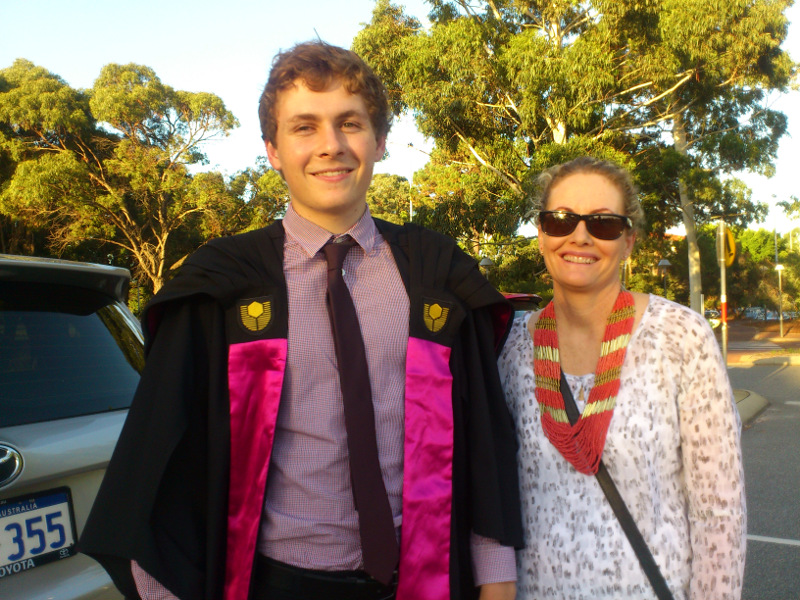Riverton have won the 2017 T20 Blast Inter-school Cricket Competition.
Author: barrycus
Lenny the Lion
Josh’s film Lenny the Lion won Best Documentary and the People’s Choice award at the NEXT GEN Short Film Festival 2017.
Lenny the Lion from Josh Cable.



Cricket U11s Round 12 v Canning Vale
Riverton Rossmoyne v Canning Vale at Piara Waters Oval, 18/02/2017.
Tim graduating from Curtin University
Upgrade Nextcloud from version 10.0.2 to 11.0.0
To upgrade Nextcloud is actually pretty simple. The instructions are very similar to my post on Migrate from ownCloud 9.1.1 to Nextcloud 10.0.2.
Please note that I have created a directory “/opt/owncloud-install/” which I use to backup files to when performing an upgrade. You can have a directory named something else, the name isn’t important. Also my Nextcloud installation is in a directory named “/var/www/owncloud”, I found it easier to leave the directory name exactly the same when I migrated from ownCloud to Nextcloud.
1. Download Nextcloud server version 11.0.0
wget https://download.nextcloud.com/server/releases/nextcloud-11.0.0.tar.bz2
2. Stop your webserver
sudo systemctl stop apache2.service
3. Backup (move) your config.php file and your data folder
sudo mv /var/www/owncloud/config/config.php /opt/owncloud-install/
sudo mv /var/www/owncloud/data /opt/owncloud-install/
4. Delete your ownCloud folder
sudo rm -rf /var/www/owncloud/
5. Extract Nextcloud 11.0.0 (please note that the tar ball doesn’t include a data folder or a config.php file)
sudo tar -xf nextcloud-11.0.0.tar.bz2 -C /var/www/
6. You now have a folder named nextcloud, I’m going to rename this folder to owncloud
sudo mv /var/www/nextcloud /var/www/owncloud
7. Move the config.php file and your data folder which you backed up in Step 3
sudo mv /opt/owncloud-install/config.php /var/www/owncloud/config/
sudo mv /opt/owncloud-install/data/ /var/www/owncloud/
8. Set the correct ownership for your Nextcloud instance (the files in the tar ball are owned by nobody)
sudo chown -R www-data:www-data /var/www/owncloud/
9. Start your webserver
sudo systemctl start apache2.service
10. Complete the upgrade to Nextcloud 11.0.0
sudo -u www-data php /var/www/owncloud/occ upgrade
Done!
Migrate from ownCloud 9.1.1 to Nextcloud 10.0.2
These instructions are based on the assumption that you have a working ownCloud (version 9.1.1) instance. To make the migration process easier I decided not to rename any existing ownCloud folders.
Some of the steps I document may not be necessary for a successful migration but they are the exact steps I used and they worked.
My server environment is as follows:
Operating System: Debian 8.6 (jessie) ownCloud version: 9.1.1 Webserver: Apache 2.4.10 ownCloud install location: /var/www/owncloud ownCloud backup location: /opt/owncloud-install
1. Download Nextcloud server version 10.0.2
wget https://download.nextcloud.com/server/releases/nextcloud-10.0.2.tar.bz2
2. Stop your webserver
sudo systemctl stop apache2.service
3. Backup (move) your config.php file and your data folder
sudo mv /var/www/owncloud/config/config.php /opt/owncloud-install/
sudo mv /var/www/owncloud/data /opt/owncloud-install/
4. Delete your ownCloud folder
sudo rm -rf /var/www/owncloud/
5. Extract Nextcloud 10.0.2 (please note that the tar ball doesn’t include a data folder or a config.php file)
sudo tar -xf nextcloud-10.0.2.tar.bz2 -C /var/www/
6. You now have a folder named nextcloud, I’m going to rename this folder to owncloud
sudo mv /var/www/nextcloud /var/www/owncloud
7. Move the config.php file and your data folder which you backed up in Step 3
sudo mv /opt/owncloud-install/config.php /var/www/owncloud/config/
sudo mv /opt/owncloud-install/data/ /var/www/owncloud/
8. Set the correct ownership for your Nextcloud instance (the files in the tar ball are owned by nobody)
sudo chown -R www-data:www-data /var/www/owncloud/
9. Start your webserver
sudo systemctl start apache2.service
10. Complete the migration/upgrade to Nextcloud 10.0.2
sudo -u www-data php /var/www/owncloud/occ upgrade
Done!
If you use the ownCloud desktop client to sync files between your ownCloud instance and your computer (mobile device) the good news is that there is no need to install the Nextcloud desktop client. Your existing ownCloud desktop client should keep working as normal after migrating to Nextcloud.
Learn more about Nextcloud
1976 VFL Preliminary Final
1976 Preliminary Final North Melbourne 10.7 (67) v Carlton 9.12 (66)
Highlights of Barry Cable
24 Kicks + 11 Handballs = 35 Disposals
ownCloud 9
I’ve just recently setup a server running ownCloud 9. The OS of the server is Debian 8 and this is the installation guide I followed Run your own cloud: Installing OwnCloud 9 on Debian 8.
To have HTTPS running on my server I used the service provided by Let’s Encrypt.
The user interface is familiar and intuitive plus the functionality for sharing files, calendars, contacts, and bookmarks is very useful. I can also share this ownCloud instance with my family and friends by creating separate accounts for them.
I was able to configure Amazon S3 as a source of external storage. I’m also utilising the ownCloud desktop client. The desktop client syncs your ownCloud folders (you can choose which folders to sync) with your computer which makes it very convenient to access and update your ownCloud from your computer.
ownCloud website –https://owncloud.org/








